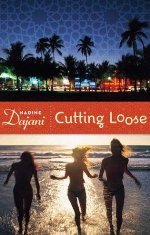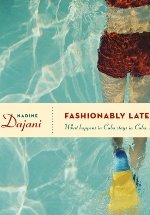For some reason, starting last August and lasting through to January, I took a chick lit break. Sometimes there is such a thing as too much of a good thing. And I’m worse than most in that I tend to gorge myself on one thing (like, say, authentic Lebanese shish taouks) until I can’t look at it anymore. I did it with the Oprah book club back in its early days, with Danielle Steel novels when I was twelve (although maybe in that case it wasn’t so much that I got sick of them, but that I realized they were all exactly the same sometime after I turned thirteen…), and I think I did it again with chick lit. And because I’m not much of a genre reader (I honestly believe that the thematic and writing range chick lit provides makes the label ‘genre’ very loosely applicable to it), it leaves me with slim pickin’s when I decide to get off a particular kick. Luckily, after Dona’s How to Salsa in a Sari, and Marian Keyes’s Anybody Out There, I think I’m back in the game.
So what did I do all these months, besides moping over winter and frantically racing against time to get the Cutting Loose manuscript in?
Here’s a partial reading list:
Girls of Riyadh by Rajaa Alsanea
I wanted to blog about this book the second I finished it. It wasn’t particularly well-written, nor especially hard-hitting or even tightly plotted. It was nonetheless a page-turner. Think of it as the chick version of The Satanic Verses – rocketed into bestsellerdom by virtue of its subject matter and the utter stupidity of its critics.
I lived in Saudi Arabia until I was nine, though not in mind-bogglingly restrictive capital of Riyadh, but in the slightly more palatable coastal city of Jeddah (based on this, I have a theory that give any city – even one in Saudi – a beach, and you’ve automatically upped it a few notches on the coolness index)
I also read this book to get a better handle on the Ranya character I wrote in Cutting Loose (she grew up in that milieu). Because even though I wasn’t one of those “Girls of Riyadh” (too young and blessed with parents who did not consider me chattel to qualify), in the eye of my mind I can still see those girls. And they really are something else, even in the conservative Middle-East. The book was controversial because apparently the Saudi Big Wigs are upset over the suggestion that their daughters actually have feelings besides piety and devotion.
It was also an interesting study in perspective for me. I read this book, and got it. I have no issues with believability, and I didn’t think it was sensationalized or exaggerated in the least. Also, the book doesn’t give a lot of cultural background – it’s clearly intended for an Arab audience (methinks). In fact, my cousins who’d read it in the original Arabic (it was published in Lebanon and banned in Saudi Arabia – surprise, surprise), were shocked it had been translated to English.
Still, I couldn’t help but wonder – what would a “Westerner” reading this think? This is different from the Princess accounts which expose an extremely narrow, rarefied world of tribal royalty. Despite its very specific subject matter, this book remains a commentary on society and male-female relationships in general. But from a perspective I’m pretty sure most of you have never been exposed to.
I would love to hear from any “Westerners” who’ve read it. I’m almost afraid to recommend it – it’s one of those books that should come with a warning label: Please do not generalize to the entire Middle East.
It was the cat’s pajamas back in August, all over the airports and bookstores, so if you’re looking for something still within the women’s fiction realm yet very different, read it, and tell me about it. I’d love to shed any light on any queries you have, or answer any “is it really like that???” type questions.
Moving on… The Shock Doctrine by Naomi Klein.
This is the first economics book to make me cry. I’m talking genuine misty, wipe-the-corners-of-your-eyes crying.
It’s about 650 pages of text, and maybe another couple hundred of notes. A little on the long side, but you don’t notice until around page 500.
To say it’s about economics is a little bit misleading, seeing how thorough and well-written, and yes – tightly plotted – it is. This is a work of non-fiction, but almost reads like fiction. Which goes to show, good writing is good writing, and always a joy to read, even if the subject matter is tragically real.
The introduction is set in a devastated post-Katrina New Orleans and recounts a simple scene that encapsulates what the entire book is about. The next chapter introduces the reader to a Montreal woman who went to the psychology ward of McGill University back in the fifties because she was often depressed and wanted to get a proper diagnosis. Forty years later she would successfully sue the government of Canada for having turned a blind eye to the torture techniques that were tried, tested and perfected on her, and on others, in the halls of that venerated university (it chills me to think this happened in my city, at a University I might have attended had I not gotten a scholarship somewhere else). The inhumane testing done on this woman would eventually become a torture instruction manual referred to as the Kubark manual used by the CIA, a sophisticated new kind of torture that uses the shock element rather than say, randomly plucking people’s fingernails off, to get suspects exactly where you want them.
The premise of Klein’s painfully detailed and thoroughly documented book is that over the past fifty years, this kind of coercion method was used to get whole societies to make decisions they wouldn’t otherwise make, if they didn’t happen to be in "shock", and that ultimately devastated them and their societies.
Not bad for an economics book. If you’re at all curious about why a place that looked as economically promising, almost like a fully developed economy with a healthy middle class as Argentina can suddenly and without much warning just collapse, this is a great reference. And written more like a novel than a reference book. As a bit of a history and economics geek, I personally could not put this one down, even though it was directly conflicting with my own writing schedule, and I’m going to read it again, because there was just too much information to absorb all at once.
And then there was The Upside of Down by Thomas Homer-Dixon.
This is a peculiar little book that tries to be strangely upbeat even as it details the utter collapse of society as we know it, in only the way really gung-ho scientists can be. “Gee, Irv, isn’t it fascinating how the complex-connectivity that brought us the Internet, abundant food and the cure for polio will also be at the root at the complete obliteration of civilization?” said the bespectacled, rotund man to his colleague as they examined the glowing green liquid in the glass beaker.It starts with the author’s trip to the Coliseum in Italy and concludes among the ruins of an ancient Roman temple in Baalbek, Lebanon , is chock-full of scientific notions and ratios like EROI (Energy Rate of Return) in between, and is not an especially easy read, but is absolutely fascinating (I would have never picked it up had it not won a bunch of awards in Canada).
The basic premise is that we’re screwed, and not just because we’ve depleted the cheapest and most efficient type of energy known to mankind, not just because of global warming, or overpopulation, or resource scarcity that will result in increasing political instability and terrorism, but because all these things are going to smash into each other at a time when global connectivity has never been higher. The butterfly effect to the power of a gazillion. It might have been a little bleak, to be honest, if the author wasn’t so positively giddy about that fact that it was high time our system broke down and made way for something healthier, more positive, and more sustainable. I’m not sure how he pulled off being so “zen” about the whole thing, but he did.
And then I rewarded myself for all this brainy reading by picking up Madeleine Wickham’s (AKA Sophie Kinsella) Cocktails for Three, about a trio of best friends keeping some pretty juicy secrets from each other.
Stay tuned for musings on the writing “process” tomorrow, seeing as I just completed Cutting Loose and have craft/writing on the brain.
Besos,
Nadine
Subscribe to:
Post Comments (Atom)




1 comment:
Post a Comment